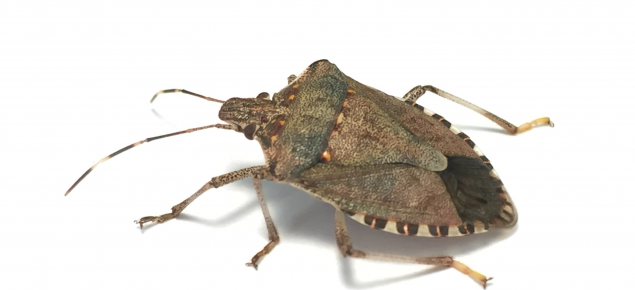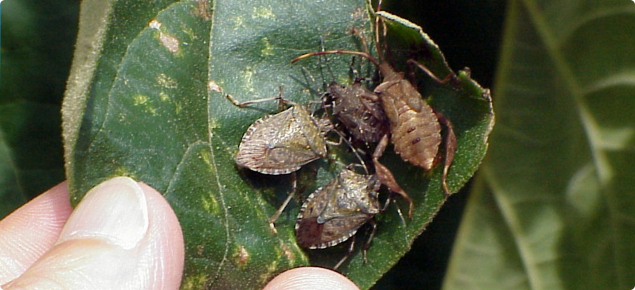BMSB are highly mobile and during the colder months in the northern hemisphere (between September and April) it is common for BMSB to take shelter in cargo, as well as vehicles and machinery, that are bound for Australia. In recent years there has been an increase in BMSB detections around the country, due to their spread throughout the United States and Europe. Stronger import measures have been put in place to help reduce the threat.
What if I find something?
Take IMMEDIATE action
If you find dead or live bugs suspected of being BMSB:
-
Don’t remove the contents of the container or package. Shut the doors and reseal.
-
Don’t allow the container to be moved – especially to an area outside if it’s in a warehouse.
-
Collect any dead or live specimens so our entomologists can confirm the species.
-
Any live bugs should be held in a container that prevents them from escaping.
Report IMMEDIATELY
In imported goods, containers and parcels
Commonwealth Department of Agriculture, Water and the Environment
- See. Secure. Report. hotline 1800 798 636
- awe.gov.au/report
You will not be prosecuted if you or someone you know has accidentally imported risk material.
On your property
WA Department of Primary Industries and Regional Development
Pest and Disease Information Service
- (08) 9368 3080
- padis@dpird.wa.gov.au
MyPestGuide
We need YOUR help
Some tips for looking:
-
Look for stink bugs on your plants or feeding damage.
-
Look for unusual aggregations of stink bugs in or on buildings.
-
They are attracted to light, and may be found in areas that are well lit at night.
-
They could possibly be found in spider webs near light sources.
Port workers / warehouse workers / transporters / importers
We need anyone who works around or receives imported goods to look for BMSB. This not only includes port workers, but anyone working in and around freight, transport, warehouses and industrial areas.
BMSB will stow away inside shipping containers, and they can be found within the goods in the container, including boxes and packaging. They also seek shelter in break bulk cargo including vehicles and machinery. If you see something take immediate action (see instructions above), and call the See. Secure. Report Hotline on 1800 798 636.
Businesses that deal with imported goods that are typically stored outside should be particularly vigilant, to prevent spread of BMSB into outdoor areas. These include:
-
Car dealerships or distribution centres that receive vehicles and machinery once clear at the border.
-
Machinery and equipment distributors.
-
Building suppliers, garden product suppliers (those that sell pots, garden ornaments and equipment).
-
Tile and ceramic distributors.
-
Distributors of imported electrical goods and components.
-
Other businesses that are in receipt of imported goods, particularly from Italy.
Watch the video below to learn more about the role of port workers in BMSB surveillance.
Purchasing goods from overseas
Anyone who purchases goods online from overseas needs to be aware of BMSB and its potential to arrive as a hitchhiker within packages.
Particular attention should be paid to second hand goods or items that may have been in storage for some time. If you receive a package that has live bugs inside, you need to take immediate action.
Re-seal the box or package to prevent further bugs escaping. If bugs have already escaped, try to catch them and put them in a sealed container. If you can, take a clear photo and immediately make a report to the See. Secure. Report hotline on 1800 798 636.
Growers and gardeners
Look out for BMSB in your crop or backyard. The most effective way to detect BMSB is by visually inspecting the underside of plant leaves. They are large bugs that emit a foul odour when disturbed. They are attracted to light and may be found in spider webs.
If you think you have seen BMSB take immediate action (see instructions above), and call DPIRD on 9368 3080.
Increasing threat
The Australian Government Department of Agriculture, Water and the Environment (DAWE) has routinely intercepted BMSB at the border, in small numbers, on a range of goods, from a range of overseas countries, for the last decade. BMSB are highly mobile and during the colder months in the northern hemisphere (between September and April) it is common for BMSB to take shelter in cargo, as well as vehicles and machinery, that are bound for Australia.
Over the past few years, BMSB detections have increased, as well as the number of countries that BMSB are coming from. The increasing threat is due to the spread of the pest in Europe, particularly Italy.
Federal import measures
DAWE is responsible for Australia’s biosecurity at our international border and manages the risk of BMSB arriving in Australia. To address the emerging risk of increasing BMSB detections in 2014, urgent response measures were put in place, which are reviewed each year.
Visit the DAWE web pages for updates, and extensive information on target high risk goods and countries, treatment options and providers, import requirements and forms, approved arrangement sites and container management.
WA detections
March 2019
Location: Bibra Lake
Outcome: Eradicated
A single BMSB was found in a DPIRD surveillance trap in an industrial area in Bibra Lake.
The department is undertaking increased surveillance in the area, including additional specialised traps, to ensure the pest has not spread. To date there have been no further detections.
December 2018
Location: Fremantle
Outcome: Eradicated
On 28 December 2018, a single live Brown marmorated stink bug (BMSB) was found in a trap at Fremantle Port. This trap was one of 14 that formed part of BMSB surveillance activities which are conducted by the Federal Department of Agriculture and Water Resources.
DPIRD has been working closely with DAWR to put in place swift and effective response measures.
A residual treatment has been applied to a 100 metre buffer zone which includes buildings and vegetation. DPIRD has a 12-week trapping program underway to determine whether the pest has spread. A total of 49 traps have now been deployed with no further detections to date.
January 2018
Location: Jandakot, Perth
Status: Following the January 2018 BMSB detection, no further bugs were found.
Outcome: Eradicated
BMSB was detected in imported electrical goods at a warehouse in Jandakot. Following the detection the bugs were reported quickly to DAWR, and the container was treated and the warehouse fumigated. Following fumigation, a single live Brown marmorated stink bug was detected outside, in the vicinity of the warehouse.
A pest controller engaged by DPIRD completed a contingency insecticide spray treatment around the perimeters of two small bushland areas close to the Jandakot warehouse to mitigate the risk of any movement of the bug. Sentinel trees were also placed in the bushland with traps.
Extensive community engagement activities with local businesses, community groups, and residents was carried out, to ensure reporting of any suspect BMSB.



